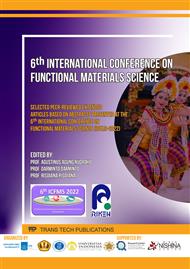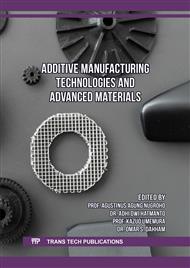p.31
p.37
p.47
p.53
p.61
p.71
p.77
p.85
p.93
The Synthesis of (1-x-y)BiFeO3-xBaTiO3-yKVO3 (x=0.33, 0.38, y=0.01) Composition and its Effect on the Electrical Properties
Abstract:
(1-x)BiFeO3-xBaTiO3-0.01KVO3 with (x = 0.33 and 0.38) (abbreviated FTV33 and FTV38) was successfully prepared using three precursors that had been synthesized before the calcination process. BaTiO3 was synthesized using the coprecipitation method, BiFeO3 was synthesized using the sol-gel auto-combustion method, and KVO3 was synthesized using the conventional solid-state method. Thermal analysis was carried out to determine the calcination temperature from 600 0C for 2h to 600 0C for 4h. X-ray diffraction (XRD) has been carried out to identify the phase after calcination at temperatures, respectively. The phase identification of the XRD pattern has been carried out by Match software shows that the powder and FTV33 and FTV38 have a pseudo-cubic structure with a P4mm space group and rhombohedral with an R3c space group. The XRD pattern is refined by the Rietveld method by Rietica software and the crystalline size is determined by MAUD software. The doping effect of KVO3 on its electrical properties was systematically investigated and show that FTV33 is more conductive and has larger capacitance grains. Based on the previous XRD analysis, Ba2+ and K+ ions replaced Bi3+ at site A. On the other hand, Ti4+ and V5+ substituted Fe3+ at site B which was different from the host's oxidation state.
Info:
Periodical:
Pages:
61-69
Citation:
Online since:
July 2023
Authors:
Keywords:
Price:
Сopyright:
© 2023 Trans Tech Publications Ltd. All Rights Reserved
Share:
Citation:



